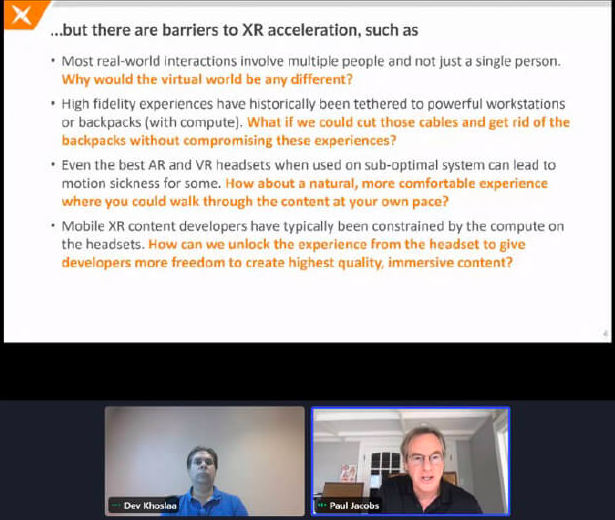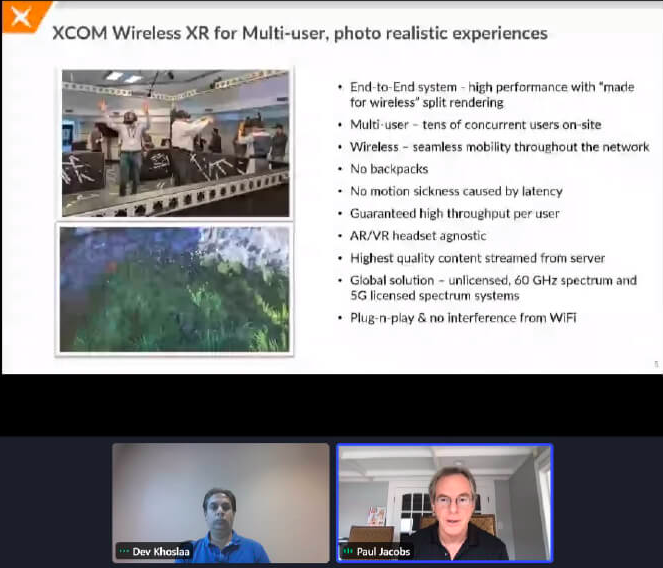Wireless XR Will Give Users Superpowers!
Imagine being transported into a fully immersive virtual world, so rich in photorealistic imagery and sensory detail that you forget it’s not real life. As advancements in enterprise virtual reality (VR) applications speed up, the underlying wireless technologies to support lifelike experiences must keep pace.
“We will give people superpowers,” our Chairman and CEO, Paul Jacobs explained during his keynote address at the July 2022 VRARA Enterprise Forum. He went on to describe the high-performance applications enabled by XCOM Labs’ innovative Wireless XR system. “We’re really just getting started with this notion of extending reality.”
In developing the gold standard in wireless XR systems, the XCOM Labs’ team has achieved low latency, high throughput, and reliability breakthroughs that solve many of the issues that previously prevented users from experiencing the full potential of this exciting technology. Gone are the bulky backpacks and cords connecting users to powerful computers, or the cumbersome lags that can oftentimes cause feelings of motion sickness or glitches. Instead, using millimeter wave spectrum in the globally available 60GHz unlicensed band, our system allows multiple users to roam freely across a large space while experiencing seamless, high-quality content.
One of the most powerful ways we’ve been able to illustrate these improvements recently is through our collaboration with The VOID, a hyper-reality experiential entertainment creator, to generate the most immersive VR experience yet. Using our highly reliable wireless system, we ditched the 22 pounds of equipment previously needed to provide such photorealistic quality visuals and moved heavy processing loads into a wireless network, or edge computer.
Jacobs explained that the breakthroughs The VOID and XCOM Labs demonstrated also apply to enterprise applications, not just entertainment.
“The experiences before were driven by the fact that you had this very heavy backpack on and power consumption was very high,” Jacobs said. “You had this big block of a battery that you had to carry around and it only lasted for about 30 minutes. Now, you’re going to be able to have extended experiences without sacrificing image quality.”
AWE attendees were transported from the 144-square-foot demonstration stage into a hyper-realistic experience that tapped into a variety of sensory details including, sight, sound, motion, and temperature. As users freely roamed the virtual space, they could interact with each other as well as the environment around them, without experiencing lags or sacrifices in the 4K video quality at 90 FPS with up to 400 Mbps per user.
These next-level immersive enterprise environments enabled by our wireless technology include learning and specialized training to industrial automation, smart warehouses, and even telemedicine.
“An expert at a remote facility will be able to instruct a novice who is doing surgery in the field, able to point out where that person needs to make incisions or do various procedures,” Jacobs explained. “The novice can even stand inside the avatar of the expert and follow their motions.”
Our system is designed for those who need the highest reliability to support their XR use cases, ensuring that wireless throughput and latency are never the limiting factors that curb human imagination.
At XCOM Labs, we believe in unlimited possibilities and delivering the unexpected. Interested in learning more about how our next-generation wireless technology can elevate your XR experience? Contact us, today!






